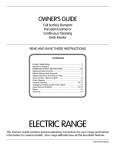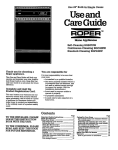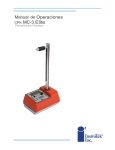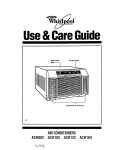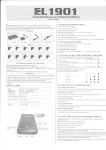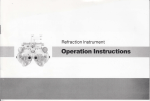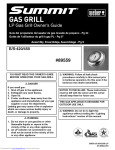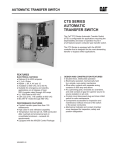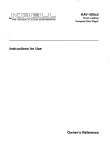Download Roper FGS397X User's Manual
Transcript
UGRiiiid CareGuide ROPER’” -. EzoIneAppliances FGS397X Thank you for choosing Roper appliance. a This Use and Care Guide will help you operate and mainta.in your new, qualitybuilt Roper range. Keep this Use end Care Guide in a safe place for future reference. Complete and mail the Product Registration Card. This card enters your warranty into our warranty system that ensures efficient claim processing, can be used as a proof of purchase for insurance claims and helps Roper to contact you immediately in the unlikely event of a product-safety recall. You are responsible for It is your responsibility to be sure that your range: Has been properly installed where it is protected from the elements, and on a floor strong enough to support its weight. (See the Installation Instructions.) Is not used by anyone unable to operate it properly. Is properly maintained. Is used only for jobs expected of a home range. Is secured by properly installed anti-tip bracket(s), with rear leveling leg(s) positioned under bracket(s). Contents Important Safety Iusauctions TO THE INSTALLER: PLEASE LEAVE THIS INSTRUCTION BOOK WITH THE UNIT. TO THE CONSUMER: PLEASE READ AND KEEP THIS BOOK FOR FUTURE REFERENCE. -2 Page PaitsAndFeatuies i using Your Range 4 Using the surface burners The electronic oven controls 4 Setting the clock : Using the electronic Minute Timer5 Usinu the Set/Cancel button Usin the oven Usinu the electronic oven control s The &en vent The storage drawer CaringForYourRange The control knobs The control panel z The surface burner grates The surface burners and cooktop z 10 The oven burner Using the Self-Cleaning cycle 10 Cleaning chart The oven light ii Before You Call For Service WkUTEUl~ :: How to get service or assistance -16 Important Safety Instructions Gas ranges have been thoroughly tested for safe and efficient operation. However, as with any appliance, there are specific installation and safety precautions which must be followed to ensure safe and satisfactory operation. To reduce the risk of fire, electrical shock, injury to persons, or damage when using the range, follow basic precautions, including the following: . FOR YOUR SAFETY n VAPORS AND LIQUIDS IN DO NOT STORE OR USE GASOLINE OR OTHER FLAMMABLE THE VICINITY OF THIS OR ANY OTHER APPLIANCE. THE FUMES CAN CREATE A FIRE HAZARD OR EXPLOSION. 1. 2. 3. 4. 8 FOR YOUR SAFETY n IF YOU SMELL GAS: OPEN WINDOWS. DON’T TOUCH ELECTRICAL SWITCHES. EXTINGUISH ANY OPEN FLAMES. IMMEDIATELY CALL YOUR GAS SUPPLIER. IMPROPER INSTALLATION, ADJUSTMENT, ALTERATION, SERVICE OR MAINTENANCE CAN CAUSE INJURY OR PROPERTY DAMAGE. REFER TO THIS MANUAL. FOR ASSISTANCE OR ADDITIONAL INFORMATION CONSULT A QUALIFIED INSTALLER, SERVICE AGENCY, MANUFACTURER (DEALER) OR THE GAS SUPPLIER. 1. Install or locate the range only in accordance with the provided Installation Instructions. It is recommended that the range be installed by a qualified installer. The range must be properly connected to the proper gas supply and checked for leaks. If needed, the range must also be properly connected to electrical supply and grounded. 4. DO NOT operate the range if it is not working properly, or if it has been damaged. 5. DO NOT use the range for warming or heating the room. Persons could be burned or injured, or a fire could start. 6. DO NOT attempt to light the oven burner during a power failure. Personal injury could result. 11. Turn pan handles inward, but not over other surface burners. This will help reduce the chance of burns, igniting of flammable materials, and spills due to bumping of the pan. 12. Use only dry potholders. Moist or damp potholders on surface burners may result in burns from steam. DO NOT let potholder touch surface burners. DO NOT use a 2. To reduce the risk of tipping of the appliance, the appliance must be secured by properly installed antitip bracket(s). To check if the bracket(s) is installed properly, remove the storage drawer (see page 8) and verify that the anti-tip bracket(s) is engaged. 3. Gas fuels and combustion can result in potential exposure to chemicals known to cause cancer or reproductive harm. For example, benzene is a chemical which is a part of the gas supplied to the range. It is consumed in the flame during combustion. However, exposure to a small amount of benzene is possible if a gas leak occurs. Formaldehyde, carbon monoxide and soot are by-products of incomplete combustion. Properly adjusted burners with a bluish burned. 9. DO NOT touch surface burners, areas near burners or interior surfaces of oven. Areas near surface burners and interior surfaces of an oven become hot enough to cause burns. During use, DO NOT touch, or let clothing or other flammable materials contact surface burners, areas near surface burners or interior surfaces of oven. Other surfaces of the range may become hot enough to cause burns; such as, the oven vent opening, the surface near the vent opening, the cooktop, the oven door and window. 10. Make sure the utensils you use are large enough to contain food and avoid boil-overs and spill-overs. Heavy splattering or spill-overs left on a range can ignite and bum you. Pan size is especially important in deep fat frying. utensils are suitable for cooktops without breaking due to the sudden change in temperature. 14. DO NOT use decorative covers or trivets over the surface burners. 15. DO NOT heat unopened containers. They could explode. The hot contents could cause burns and container particles could cause injury. 16. Grease is flammable and should be handled carefully. Let fat cool before attempting to handle it. DO NOT allow grease to collect around cooktop or in vents. Wipe spillovers immediately. 17. DO NOT use water on grease fires. Never pick up a flaming pan. Smother flaming pan on range by covering with a well-fitted lid, cookie sheet or flat tray. Flaming rather than a yellow flame will minimize incomplete combustion. age 2 grease outside of pan can be extinguished with baking soda or, if available, a multipurpose dry chemical or foam-type extinguisher. 18. Never leave surface burners unattended at high heat settings. A boil-over could result and cause smoking and greasy spill-overs that may ignite. 19. Make sure surface burners are off when you are finished, and when you are not watching. 20. Use care when opening oven door. Let hot air or steam escape before removing or replacing food. 21. Always position oven rack(s) in desired location while oven is cool. 22. DO NOT store flammable materials on or near the range. They could explode or burn. 23. DO NOT store things children might want above the range. Children could be burned or injured while climbing on it. DO NOT use oven cleaners. No commercial oven cleaner or oven liner protective coating of any kind should be used in or around any part of the oven. 32. Before self-cleaning the oven, remove broiler pan, broiler grid, oven racks and other utensils. Do not use your oven to clean miscellaneous parts. 33. DO NOT repair or replace any part of the range unless specificahy recommended .in this manual All other servicing should be referred to a qualified technician. 34. Disconnect the electrical supply before servicing the range. DO NOT leave children alone or unattended in area where the range is in use. They should never be allowed to sit or stand on any part of the range. They could be burned or injured. 25. NEVER use a match or other flame to look for a gas leak. Explosion and injury could result. 26. Know where your main gas shut off valve is located. 27. Keep range vents unobstructed. 28. Clean your range regularly. See care and cleaning instructions in this manual 29. Be sure all range parts are cool before cleaning. 30. DO NOT clean door seal. It is essential for a good seal Care should be taken not to rub, damage, or move the seal. Clean only parts recommended in this Use and Care Guide. 31. 24. ’ SAVE THESE INSTRUCTIONS . Parts & Features Electronic oven control Oven vent Control panel Sufacebumers Surface burners and grates Ovenbumer (not shown) Storage drawer 1 \ Page 3 Using Your Range Surfaceburner marker I Left koit control knob L&rear control knob Using the surface burners Pushfnandturn Control knobs must be pushed in, then turned to the LlTE position. The clicking sound is the ignition sparking. To stop the clicking sound after the burner lights, turn the control knob back to a desired setting. The control knob can be set anywhere between HI and OFF. Surface burner markers The solid dot in the surface burner marker shows which surface burner is turned on by that knob. Until you get used to the settings, use the following as a guide. For best results, start cooking at the high settings, then turn the control knob down to continue cooking. Use IJTE to light the burner. After the burner lights, turn control back to a desired setting to stop the clicking of the ignition. Use a high setting to start food cooking: to bring liquids to a boil. Use a medium setting to continue cooking or to fry chicken or pancakes; for gravy, pudding and icing; to cook large amounts of vegetables. Use a low setting to keep food warm until ready to serve. NOTE: Do not cook with the control in the LlTE position. Page 4 Right uont control knob Right rear control knob Ovenlight SW%& any of a prolonged power Surface burners can be manually lighted. Hold a lit match near a burner and slowly turn the control knob to the LlTE position until the burner lights. After the burner lights, turn the control knob to the desired setting. Burn, Fire And Explosion Hazard . Burner flame should not extend beyond the edge of the cooking utensil. The flame can burn you and cause poor cooking results. . Be sure all control knobs are turned to OFF when you are not cooking. Someone o&d be bumedorafirecouldstartifa burner is accidentally left ON. . If the flame should go out while cooking, or if there is a strong gas odor, turn the burners OFF. Wait five minutes for the gas odor to disappear, before relighting burner. If gas odor is still present, see safety note on page 2. Failure to follow these precautions could result in explosion or fire. . Do not attempt to light the oven burner during a power failure. Personal injury could result. The electronic oven controls There are three parts in the oven control section: - The digital display. - The command buttons. - The TimeRemp Set Knob and Set/ Cancel button. Instructions for each oven control are covered on the following pages. Read them carefully. When you first plug in the range, the display will show four flashing “8”s. If after you set the clock (page 5) the display again shows four flashing “8”s your electricity was off for a while. Reset the clock. Digital display/clock When you are not using the oven, this is an accurate digital clock. When using the oven or Minute Timer, the display will show the time, temperature settings and what command buttons have been pressed. When showing the timeofday, the display will show the hour and minutes. When using the Minute Timer, the display shows minutes and seconds in the following sequence: . For settings from 0 minutes to 1 minute 55 seconds, the display will increase in 5-second increments. n For settings from 2 minutes to 9 minutes 50 seconds, the display will increase in lo-second increments. . For settings from lo-59 minutes, the display will increase in l-minute increments. n For settings from 1 hour to 1 hour 55 minutes, the display will increase in 5minute increments. n For settings from 2 hours to 9 hours 50 minutes, the display will increase in lo-minute increments. When using Cook Time, the display shows hours and minutes. Command buttons The command buttons tell the oven what to do and in what order. A few examples: - Clock tells the oven you are going to set the clock. - Set/Cancel tells the oven to turn off. Each command button (except SeV Cancel) has its own indicator. The indicator comes on when you touch the command buttons. Time/Temp Set Kuob Once you’ve pushed a command button to tell the oven what you want it to do, you’lI use the Time/remp Set Knob to set a temperature or time. Turning the Time/remp Set Knob clockwise increases the number on the display. Turning the Time/remp Set Knob counterclockwise decreases the number on the display. Setting the clock Using the electronic Timer Minute The Minute Timer does not start or stop the oven. It works like a kitchen timer. It can be set in minutes and seconds up to 9 hours 50 minutes. You will hear three beeps when the set time is up. 1. Push the Timer button. The TlMER indicator will come on and the large display will show ‘0:OO”. 2. Turn the Time/remp Set Knob until the desired time shows in the large display. The Minute Timer will begin counting down 2 seconds after the time is set. When time is up, you will hear three beeps. To cancel the Minute Timer: n Push the Clock button. The TIME indicator will show in the display. Release the Clock button. Turn the Time/Temp Set Knob until the correct time shows in the large display. Push the Set/Cancel button to complete time-of-day entry. Push the Timer button and hold it down for 3 seconds until time-ofday appears in the large display or turn the TimeA’emp Set Knob until “0:OO” shows in the large display. Using the Set/Cancel button The Set/Cancel button will cancel any command except for times set with the Timer button. The large display will then show the time-of-day or, if Minute Timer is also being used, the time remaining. Using the oven Beking/roasting 1. Position the rack(s) properly before turning on the oven. To change rack position, pull rack out to stop, raise front edge and lift out. When using one rack, the rack should be placed so the top of the food will be centered in the oven. Always leave at least 1 l/2 to 2 inches (4-5 cm) between the sides of the pan and the oven walls and other pans. 2. Push the Bake Temp button. “--OF” will show in the small display. NOTE: If the oven door is latched when you try to bake/roast, “door” will appear in the large display and you will be unable to continue. If the LOCK indicator is on, wait until it goes off. Then move the Lock Lever aB the way to the left to unlatch the door. 3. When baking, preheat the oven for 10 minutes. (Preheating is not needed when roasting.) To set a baking/roasting temperature, turn the Thne/Temp Set Knob until the desired temperature shows in the small display. The display will increase in 5°F increments. The BAKE and ON indicators will come on. The burner will light in 50-60 seconds. The oven is preheated when. you 4. hear one beep. 5. Put food in the oven. During baking/roasting, the oven burner will turn on and off to keep the oven temperature at the setting. 6. When baking/roasting is done, push the Set/Cancel button or turn the Time/Temp Set Knob until “--OF” shows in the small display. The oven will then shut off. NOTE: The oven automatically turns off after 11 hours, 55 minutes. Page 5 Broiling 1. Position the rack before turning the oven on. Refer to “Broiling chart” below for recommended rack positions and broiling times. 2. Preheat the broiler for 5 minutes with the oven door closed. This heats the special ceramic coating on the burner reflector, which then radiates the heat rays into the food. To preheat, push the Broil button. “---I will show in the small display and the BROIL indicator will come on. NOTE: If the oven door is latched when you try to broil, “door” will appear in the large display and you will be unable to continue. If the LOCK indicator is on, wait until it goes off. Then move the Lock Lever all the way to the left to unlatch the door. 3. You can broil at one of two temperatures. To cook at the lower temperature, turn the Tirneflemp Set Knob one click and “lo” will appear in the small display. To cook at the higher temperature, turn the TimeA’emp Set Knob two clicks and “hi” will appear in the small display. When the oven turns on, the ON indicator will come on. The burner lights automatically in 50-60 seconds. 4. After preheating, put the broiler pan and food on the rack and completely close the oven door. 5. When broiling is done, push the Set/Cancel button. The time-of-day will then show in the large display. Page 6 Broiling tips . Use the broiler pan and grid for broiling. They are designed to dram excess liquid and fat away from the cooking surface to help prevent spatter, smoke or fire. . If you broil small quantities, you may want to use a small broiler pan. They are available in the housewares section of many department stores. I For best broiling results, preheat at BROIL for 5 minutes. Do not preheat with broiler pan in place. n Rack position determines how infrared rays cook your food. The lower the position, the more broiler grid area covered by the rays. See “Broiling chart” below for more information. n To sear meat, place broiler pan at one of the higher rack positions so that meat is very near the flame. 9 Small steaks, hamburger patties, etc., may be broiled in the higher rack positions. . To cook large steaks and other thick cuts of meat well done, move them to a lower rack position after searing. l n Refer to “Broiling chart” below for correct broiling tunes. After broiling, remove the broiler pan from the oven when you remove the food. Drippings will bake on the pan if it is left in the heated oven. FireHazard I Place meat the axrect distance from the burner. Meat placeii too close to the burner may spatter, smoke, bum or catch fire during broiling. . To ensure adequate grease drainage, do not use cookie sheets or similar pans for broiling. Also, covering the broiler grid with foil is not recommended. Poor drainage of -se may result in fire. n Broiling chart The times and temperatures shown are provided as a general guide. Both may be varied to brown food or to achieve desired doneness. T FOOD SIZE Bacon Thin Beef, ground 1’ thick Beef, steak rare medium well rare medium well 3/4 - 1 l/4’ 1 l/4-2 TIMElNMINuTEs RACK PO!SlTIOb IST SIDE 2nd from top 4-6 Middle 6 4 2nd from top 2nd from top Middle 2nd from top 2nd from top Middle : 7 6 6 12 2 3 5 4 6 12 25 - 30 15 10 - 15 12 Chicken 2 lb. split Pieces Fish l/2’ fillet 1 l/2 lb. whole 2nd from top 2nd from top Ham l/2’ thick 2nd from top Lamb chops l/2’ thick 2nd from top Pork chops l/2’ thick 2nd from top Middle Middle 2ND SIDE 7 - 9 (skin side down) 10 5 d--+ 6 4 Using the electronic control oven The electronic oven control will turn the oven on and off at times you set ... even when you are not around. Automatic baking/roasting is ideal for foods which do not require a preheated oven, such as meats and casseroles. Do not use the automatic cycle for cakes, cookies, etc. ... undemking will result. To start baking/roasting now and stop automatically: . 1. Position the oven rack(s) properly and place the food in the oven. 2. Make sure the clock is set to the correct time-of-day. (See “Setting the clock” on page 5.) 3. Push the Cook Time button. “0:OO” will show in the large display and the HR indicator will come on. 4. Turn the Time/Temp Set Knob clockwise until the desired bakfng/ roasting time, up to 11 hours 55 minutes, shows in the large display. To see the start tune, push the Cook Time button and hold it for 3 seconds. 5. Push the Bake Temp button and set the desired temperature. The small display will show the set temperature and the time remaining. The OVEN, TIME, BAKE and ON indicators will come on. 6. The display will count down in 5and lo-minute increments. 7. When baking/roasting time is completed, the oven will turn off automatically, beep 3 times, and the time-of-day will show in the large display. To delay start and stop automatically: 1. Position the oven rack(s) properly and place the food in the oven. 2. Make sure the clock is set to the correct time-of-day. (See “Setting the clock” on page 5.) 3. Push the Cook Time button. ‘0:OO” will show in the large display and the HR indicator will come on. 4. Turn the Time/Temp Set Knob clockwise until the desired baking/ roasting time shows in the large display. 5. Push the Stop Time button. The DELAY, OVEN, STOPand TIME indicators will come on. Turn the TimeITemp Set Knob clockwise until the desired stop time shows in the large display. The oven will beep once every 10 seconds until a baking/roasting temperature is selected. 6. Push the Bake Temp button and set the desired temperature. The BAKE indicator will come on. 7. Changes can be made at any time by pressing a command button. 8. When the start time is reached, the DELAY and OVEN indicators will go off. The display will show the set temperature and the ON indicator will come on. 9. When the baking/roasting time is completed, the oven will turn off automatically, beep 3 times, and the tune-of-day will show in the large display. To cancel the oven control setting: n Push the SetlCancel button or turn the Time/Temp Set Knob until ‘0:OO” appears in the large display. The time-of-day will then show in the large display. To avoid sidmess and food waste when using delay start: nDonotusefoodsthatwillspoil while waiting for axAcing to start, such as dishes with milk or eggs, meam soups, and cooked meats or fish. Any food that has to wait for cooking to start should be very cold or frozen before it is put in the 0veL MOST UNFROZEN FOODS SHOULDNEVER STAND MORE THAN TWO HOURS BEFORECOOKING STARTS. ADOnot use foods containing baking powder or yeast when using delay start. They will not rise properly. nDonotallowfoodtoremainin oven for more then two hours after end of cooking cycle. . Page 7 The oven vent The storage drawer Replacing the storage drawer: The storage drawer is for storing pots and pans. The drawer can be removed to make it easier to clean under the range, and to check for installation of the antitip bracket(s). Use care when handling the drawer. Removing the storage drawer: Hot air and moisture escape from the oven through a vent located under the backguard. The vent is needed for air circulation. Do not block the vent. Poor baking will result. Burn Hazard When the oven is ON, pans and pan handles left near the oven vent can become hot enough to burn the user and to melt plastics. Use potholders to move pans. Never store plastics, paper or other items that could melt or burn near the oven vent, or any of the surface burners. 1. Make sure ball bearings on oven slide rail are positioned toward the front of the opening. 2. Fit ends of drawer slide rails into the oven slide rails on both sides of opening. 3. Slide drawer closed. 1. Empty drawer of any pots and pans before removing drawer. Pull drawer straight out to the stop. 2. Push up black plastic lever on both sides of drawer. To verify that the anti-tip bracket(s) is engaged: Remove storage drawer. Look to see if the anti-tip bracket(s) is attached to floor with screws. n Make sure rear leveling leg(s) is positioned under bracket(s). H See “Important Safety Instructions” on page 2 and Installation Instructions for further details. NOTE: The range will not tip during normal use. Tipping can occur if excessive force or weight is applied to open door without anti-tip bracket(s) properly secured. n n 3. Pull drawer out a little farther until levers stay in “up” position. Pull drawer the rest of the way out. Page 8 Caring For Your Range The surface Bum, Electrical Shock, Fire And Explosion Hazard .Make sure all controls are OFF and the range is wol before cIeaning. . Do not use oven cleaners, bleach or rust removers. . Do not use gasoline or other flammable liquids or vapors to clean this or any other appliance. Keep the appliance area clear and free from combustible materials, gasoline and other flammable vapors and liquids. . Do not obstruct the flow of combustion and ventilation air. Failure to follow these guidelines could result in bums, electrical shock, fire or explosion. n The control knobs 1. Turn control knobs to the off position. 2. PuIl control knobs and command buttons straight off. 3. Wash in warm, soapy water. 4. Rinse well and dry completely. Do not soak. The control burner grates 1. Make sure all surface burners are off and the surrounding parts are cool. 2. Lift off the burner grates. 3. Wash the grates with warm-soapy water or in a dishwasher. Use a nonabrasive plastic scouring pad for heavily soiled areas. Rinse and dry well. 4. Replace burner grates. The surface cooktop burners and Burner cap soiled or clogged, use a cotton swab or a soft cloth to clean the area. If needed, use swab or cloth with ammonia, white vinegar or warm water. For cooked-on soil, use a medium- to stiff-bristle tooth brush. DO NOT USE HARD OR SHARPOBJECTSTO CLEAN IGNlTOR SLOT. DO NOT USE CLEANING SOLUTIONS. NOTE: Ignitor slot should remain clean as long as burner cap is seated properly on burner. Occasionally check burner cap to make sure it is level and covers burner completely. Gas must flow freely through the ignitor slot for the burner to light properly. This area must be free of any soil and be kept protected from boil-overs and spill-avers. ALWAYS keep the burner caps in place whenever a surface burner is in use. 5. After cleaning the igniter slot, replace the burner cap and burner grate. Typical surfaceburner flame panel 1. Wipe with warm, soapy water or spray glass cleaner, and a soft cloth. 2. Rinse well. 3. Dry with soft cloth. 4. Replace control knobs and command buttons by pushing them firmly into place. NOTE: When cleaning, never use steel wool. abrasives, or commercial oven cleaners which may damage the finish. After cleaning, make sure alI control knobs point to the off position. Make sure you have not turned oven on when replacing buttons. If oven has been turned on, push Set/Cancel button. The cooktop and burner box areas are specially designed to make cleaning easier. Since the four burners are sealed, cleanups are easy and convenient. Cleaning the burners Always clean the burner caps after a spill-over. Keeping the burner caps clean wil.l prevent improper ignition and an uneven flame. To clean, use warm, soapy water and a soft cloth. If burner caps must be removed for soaking, follow these steps: 1. Remove the burner grates and burner caps by pulling upward. 2. Soak burner cap in warm, soapy water. 3. After soaking, wipe with a soft cloth or a nonabrasive scrubbing pad or cleanser. Do not clean burner cap in dishwasher or SelfCleaning Oven. Rinse and dry well. 4. For proper flow of gas and ignition of the burner, DO NOT ALLOW SPILLS,FOOD, CLEANING AGENTS OR ANY OTHER MATERIAL TO ENTER THE IGNITOR SLOT. If the slot becomes 6. Occasionally check the burner flames for proper size and shape as shown. If flames lift off ports, are yellow, or are noisy when turned off, you may need to clean the burners. If ports are clogged, clean with a cotton swab or a soft cloth. If needed, use swab or cloth with ammonia, white vinegar or warm water. For cooked-on soil, use a medium- to stiff-bristle tooth brush, brushing out away from center of burner. If adjustment is needed, call a qualified technician for service. 7. To replace burner cap, make sure cap is properly aligned and leveled. Make sure that the locating pegs in the burner body fit into the recess in the underside of the cap. The cap must be correctly seated on the burner body for proper operation of the burner. continued on next page Page 9 9. Turn the burner on to determine if it wik light. If the burner does not light after cleaning, contact an authorized RopetiM service technician. Do not service the sealed burner yourself. 9. The bottom area of the surface burner grate is not covered by porcelain enamel and therefore should be dried thoroughly to prevent rusting of the prongs. Also, due to the glass-like nature of enamel it may sometimes chip at the prong area; however, this does not affect the performance of the range. Using the Self-Cleaning The Self-Cleaning cycle uses very high heat to burn away soiL Before you start, make sure you understand exactly how to use the Self-Cleaning cycle safely. Before you staxt The oven burner A properly adjusted and well-maintained burner produces a flame which has an inner cone of bluish-green and an outer mantel of dark blue (see below). The flame should burn evenly; blowing or lifting should not occur. If the burner flame looks any different, contact an authorized Rope?’ service technician for adjustment. I Hand-cleanframe I Hand-clean door around edge I DO NOT hand-clean Dark blue Typica.loven and broil burner game Page 10 4. If you want the oven racks to remain shiny, remove from the oven and clean them by hand. Otherwise, put oven racks on second and fourth guides (guides are counted from bottom to top). After racks are cleaned in the SelfCleaning cycle, they become harder to slide. See page 12. Heat and odors are normal during the Self-Cleaning cycle. If needed, remove them by opening a window or by tumhrg on a vent hood or other kitchen vent during the cycle. cycle seal 1. Clean the areas shown by hand. They do not get hot enough during the Self-Cleaning cycle for soil to burn away. Use hot water and detergent or a soapy steel wool pad on ... n The inside of the door around the edge. (The window may also require hand-cleaning.) n The frame around the oven. Do not clean, move or bend the fiberglass seal. Poor cleaning and poor baking will result. 2. Remove the broiler pan and any pots and pans you may have stored in the oven. NOTE: The broiler pan (without grid) can be cleaned in the oven only if most of the soil has been removed by hand-cleaning or a dishwasher. The chrome broiler grid wih discolor if cleaned in the Self-Cleaning cycle. 3. Wipe out any loose soil or grease. This wi.Uhelp reduce smoke during the Self-Cleaning cycle. Personal fnjury And Product Damage Hazard n Do not touch the oven during the Self-Cleaning cycle. It could burn you. n Do not use commercial oven cleaners in your oven. Cleaners may produce hazardous fumes or damage the porcelain finish. n Do not we foil or other liners in the oven. During the Self-Cleaning cycle foil can bum or melt and damage the oven surface. . Do not block the vent during the Self-Cleaning cycle. Air must move freely for best cleaning results. . Do not leave plastic utensils near the vent. They may melt. Setting the controls 1. Make sure the Clock is set to the correct time of day. (See “Setting the clock” on page 5.) 2. Move the Lock Lever all the way to the right-the Clean position. To start cleaning immediately: Push the Clean button. A 3-hour Self-Cleaning cycle will be set automatically. “3:OO” will show in the large display. The CLEAN and TIME indicators on the left side of the display and the CLEAN and ON indicators on the right side of the display will come on. NOTE: If the Clean button is pushed when the door is not latched, “door” will appear in the large display. Move the Lock Lever all the way to the right to latch the door. If any other command button is pushed when the door is latched, “door” will appear in the large display and you will be unable to continue. Move the Lock Lever back to the left to unlatch the door after the LOCK indicator goes off. To delay start of cleaning: Push the Clean button. Immediately push the Stop Time button. Immediately turn the Time/Temp Set Knob to the new stop time, three hours from the tune you want cleaning to start. The TIME, CLEAN, DELAY and STOP indicators will come on. After the Self-Cleaning cycle is started, the LOCK indicator will come on when the oven temperature exceeds normal baking temperatures. The Lock Lever must not be moved and the door cannot be opened when this indicator is on. special tips 6. After the self-Cleaning cycle is completed, the CLEAN indicator will go off and the time-of-day will show in the large display. Keep the kitchen well ventilated during the Self-Cleaning cycle to help get rid of heat, odors and smoke. mClean the oven before it gets heavily soiled. Cleaning a very soiled oven takes longer and results in more smoke than usual n If the Self-Cleaning cycle does not get the oven as clean as you expected, the cycle may not’have been set long enough or you may not have prepared the oven properly. Set the Self-Cleaning cycle longer the next time and hand-clean areas noted on page 10. n 7. When the oven reaches normal baking temperatures, the LOCK indicator will go off. Move the Lock Lever back to the left. Do not force it. Wait until it moves easily. 8. AtIer the oven is cool, wipe off any residue or ash with a damp cloth. If needed, touch up spots with a soapy steel wool pad. To stop the Self-Cleaning cycle at any time: 1. Push the Set/Cancel button, 2. When the LOCK indicator goes off, move the Lock Lever back to the left. Do not force it. Wait until it moves easily. How it works During the Self-Cleaning cycle, the oven gets much hotter than it does for baking or broiling ... approximately 875°F (468%). This heat breaks up grease and soil and burns it off. This graph shows approximate temperatures and times during a SelfCleaning cycle for three hours. Self-Cleaning cycle-three-hour setting (Approximate temperatures and times) 1000°F 538°C 800°F 427°C 600°F 316°C 400°F 204°C 200°F 93T START 1 hr. 11l2lus. 2hrs. 2 l/2 hrs. 3 hrs. 3 1/2hE.. STOP Notice that the heating stops when the 3-hour setting is up, but that it takes longer for the oven to cool down enough to unlock. Page 11 Burn And Electrical Shock Hazard Make sure all controls are OFF and the range is cool before cl-g. result in burns or electrical shock. PART Exterior surfaces (other than control panel) areas. Surface burner grates Surface burners and burner caps HOW TO CLEAN WHAT TO USE Warm, soapy water and a soft cloth. Nonabrasive plastic scouring pad for heavily soiled Failure to do so fan Wipe off regularly when range is COOL Do not allow food containing acids (such as vinegar, tomato or lemon juice) to remain on surface. Acids may remove the glossy fmish. Also, wipe up milk or egg spills when cooktop is ~1. n Do not use abrasive or harsh cleansers. n n Warm, soapy water and a nonabrasive plastic scouring pad. Clean in a dishwasher. Wash with other cooking utensils. Dry completely. ADOnot place in Self-Cleaning Oven. Warm, soapy water and a soft cloth. Warm, soapy water and a soft cloth or a nonabrasive plastic scouring pad. . Remove burner grates. n Wipe off spills immediately after burner has cooled For cooked-on food: . Remove burner cap. l Soak cap in warm, soapy water. n Wipe with soft cloth or nonabrasive plastic scouring pad. n Rinse and dry well. . If ignitor slot and ports are clogged, clean with a cotton swab or a soft cloth. If needed, use swab or cloth with ammonia, white vinegar or warm water. For cooked-on soil, use a medium- to stiff-bristle tooth brush. l Do not clean burner caps in dishwasher or SelfCleaning Oven. See pages 9 and 10 for more information. Cotton swab or soft cloth with ammonia, white vinegar or warm water. Medium- to stiff-bristle tooth brush. n n Control knobs Warm, soapy water and soft cloth. . Wash, rinse and dry well. . Do not soak. Control panel and trim Warm, soapy water or spray glass cleaner, and a soft cloth. l Broiler pan and grid Warm, soapy water or a soapy steel wool pad. Oven racks Use Self-Cleaning cycle. Warm, soapy water or soapy steel wool pads. . Wash, rinse and dry well. Follow directions provided with cleaner. . Clean after each use. . Wash, rinse and dry well n Do not clean in the Self-Cleaning Oven. (See note on page 10.) . Leave in oven during Self-Cleaning cycle. Wash, rinse and dry well Use soapy steel wool pads for heavily soiled areas. NOTE: The oven racks will discolor and be harder to slide when left in the oven during the Self-Cleaning cycle. If you want them to stay shiny, remove from the oven and clean by hand. If racks are left ln the oven during the Self-Cleaning cycle, apply a small amount of vegetable oil to the sides of the racks to make them easier to slide. n Oven door glass Spray glass cleaner or warm, soapy water and a nonabrasive plastic scouring pad. . Make sure oven is cool. . Follow directions provided with the cleaner. . Wash, rinse and dry well. Self-Cleaning Oven For areas outside the SelfCleaning area use warm, soapy water or soapy steel wool pads. . Follow directions starting on page 10, “Using the Self-Cleaning cycle. ” . Do not use commercial oven cleaners. mDo not use foil to line the bottom of your SelfCleaning Oven. Page 12 The oven light To replace the oven light: The oven light will come on when you push the Oven Light Switch on the control panel. Push the switch again to turn off the light. Ektrical Shock And Personal Injury Hazard n Make sum oven and light bulb are cool and power to the oven llm been turned off before repking the light bulb. Failure to do so oould result in electrical shock or bums. n The bulb aver must be in place when using the oven The cover protecta the bulb from breaking, and from high oven temperatures. Since bulb cover is made of glass, be careful not to drop it. Broken glass could cause injuq. 1. Unplug appliance or disconnect at the main power supply. 2. Remove the glass bulb cover in the back of the oven by screwing it out counterclockwise. 3. Remove the light bulb from its socket. Replace with a IO-watt appliance bulb. 4. Replace the bulb cover by screwing it in clockwise. Plug in appliance or reconnect at the main power supply. NOTE: Make sure oven light is off during the Self-Cleaning cycle. Keeping oven light on will shorten bulb life. Page 13 Before You Call For Service If you are having an operating problem, check the chart to see what the cause might be before you call for assistance. OPERATING PROBLEM Nothing operates. mRange is properly connected to gas and electrical supplies. . Your home’s main fuse has blown or circuit breaker has tripped . Control knob is set in the correct position. . The flow of combustion and/or ventilation air to the range is blocked. Oven will not operate. . The electronic controls are set correctly. Seepages 4-7. . You have programmed a delay start time. Burner fails to light. . Range is connected to electrical power. . Your home’s main fuse has blown or circuit breaker has tripped. . Burner ports are clogged. Burner flames are uneven. . Burner ports are clogged. Burner flames lift off ports, are yellow, or are noisy when turned off. LI;~F Page 14 popping noise WHATTOJIO CHECK IF Contact an authorized Rope? service technician to reconnect range to gas and/or electrical supply. (See Installation Instructions.) I Replace fuse or reset circuit breaker. In case of prolonged power failme, manually light burners (see page 4). I Set control knob correctly, if needed. n n . Reset controls, if necessary. Contact an authorized RopeP service technician to reconnect range to electrical supply. (SeeInstallation Instructions.) n Replace fuse or reset circuit breaker. In case of prolonged power failure, manually light burners (see page 4). n Clean with a cotton swab, soft cloth, or medium- to stiff-bristle tooth brush (see page: 9 and 12). n . Clean with a cotton swab, soft cloth, or medium- to stiff-bristle tooth brush (see page! 9 and 12). If this fails, call an authorized RopeP service technician for service. n .Bumer is wet from washing. Remove blockage to airflow to and around range. Contact an authorized Rope? service technician to check air/gas mixture. . Let dry. OPERATING PROBLEM Control knob(s) will not WHATTODO CHECK IF nYOUpushed in knob(s) before trying to n Push in knob(s) before turning. n Reset clock if necessary. turn. If the Self-Cleaning cycle will not operate. Cooking results are not what you expected The oven temperature seems too low or too high. . The clock shows the correct time of day. mThe Lock Lever is all the way to the right. #You have set a delay start time. . Flame size fits the cooking utensil being used. . Pans are the size called for in the recipe. . You are following a tested recipe from a reliable source. . The cooking utensils have smooth, flat bottoms and fit the surface burners. . When baking, you have preheated the oven as the recipe calls for. . When baking, you have allowed 1 l/2 to 2 inches (4-5 cm) on all sides of the pans for air circulation. l When broiling, you have completely closed the oven door. The broiler provides best cooking results with the oven door closed. ‘Your old oven was accurate. Your old oven may have shifted gradually while your new oven may be more exact. Slide Lock Lever all the way to the right, if necessary. n Wait until the delay start time is reached. n mAdjust flame size to fit cooking UtensiL n Use correct-size pans. n Modify recipe or find a new recipe. muse cooking utensils with smooth, flat bottoms. n Preheat the oven according to recipe’s specifications. n Reposition pans for best air circulation. n Completely close oven door. . If, after using the oven, you are not satisfied with the temperature settings, they can be adjusted by an authorized RoperSYservice technician. (See “How to get service or assistance” on page 16.) [f there has heen a power interruption, the display will flash “88:88”. . Reset the clock (page 5). “E” followed by a number Irom 1 to 8 shows in the 3nall display. . Call for service. (See “How to get service or assistance” on page 16.) Page 15 LIMITED WARRANTY ZEEE’. HomeAppUances LENGTH OF WARRANTY PRODUCTS COVERED WHAT WE WILL PAY FOR FULL ONE YEAR All Roper Appliances Replacement parts and repair labor to correct defects in materials or workmanship. Refrigerators Freezers Air Conditioners Dehumidifiers Replacement parts and repair labor for the sealed refrigeration system (compressor, evaporator, condenser, drier or connecting tubing) which we find to be defective in materials or workmanship. Microwave Ovens Repair or replacement of magnetron tube which we find to be defective in materials or workmanship. Automatic Washers Repair or replacement of any part of the gear case assembly which we find to be defective in materials or workmanship. (From date of purchase) WARRANTY FULLFwEYEARwARRANlY ii!EEaPSTHYEAR LIMITED 2ND-5TH YEAR WARRANTY WHAT WE WILL NOT PAY FOR A. SERVICECALLS TO: 1. Correct the installation of your appliance. 2. Instruct you how to use your appliance. 3. Replace house fuses or correct house wiring or plumbing. 4. Replace owner accessible light bulbs. B. Repairs when appliance is used in other than normal, single-family household use. C. Pick up and delivery. Your appliance is designed to be repaired in the home. D. Damage to appliance caused by accident, misuse, fire, flood, acts of God, or use of product not approved by US. E. Any labor costs during the limited warranties. This Roper appliance is warranted by Whirlpool Corporation. Under no circumstances shall it be liable under this warranty for incidental or consequential damages and all implied warranties are limited to the same tune periods stated in the express warranties for Roper Brand Appliances. Some states do not allow the exclusion or limitation of incidental or consequential damages or limitations of how long an implied warranty may last, so the above limitations or exclusions may not apply to you. This warranty gives you specific legal rights, and you may also have other rights which vary from state to state. Outside the United States, a different warranty may apply. For details, please contact your franchised Roper distributor or military exchange. HOW TO GET SERVICE OR ASSISTANCE If you need service, first see the “Before You Call For Service” section of this book. If you still need service after checking this section additional help can be found if you: . Contact your selling dealer for the authorized servicer in your area? OR . Phone 1-806~@ROPER(l-800447-6737) between 8:00 a.m. and 4:30 p.m. Eastern Time, Monday through Friday: OR ‘For further information, write to: Consumer Relations Dept., Roper Brand Appliances, 2000 M-63 North, Benton Harbor, MI 49022: *When requesting assistance, please provide the model and serial numbers, date of purchase, and a complete description of the problem. The model and serial numbers are located beneath the removable cooktop (see illustration on page 3). If you are not satisfied with the service received, contact the Major Appliance Consumer Action Panel (MACAP). MACAP is a group of independent consumer experts that voices consumer views at the highest levels of the major appliance industry. Contact MACAP only when the dealer, authorized servicer or Roper Brand Appliance warrantor have failed to resolve your problem: Major Appliance Consumer Action Panel 20 North Wacker Drive Chicago, IL 60606 MACAP will in turn inform us of your action. Part No. 36-364523-03-O/4321143 01991 Whirlpool Corporation TM Trademark / SM Service Mark of Whirlpool Corporation Printed in U.S.A.
















